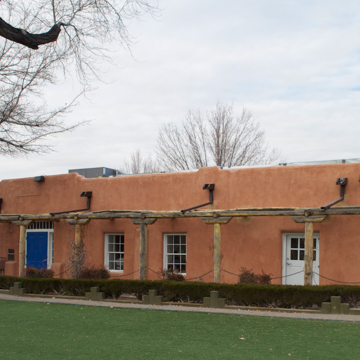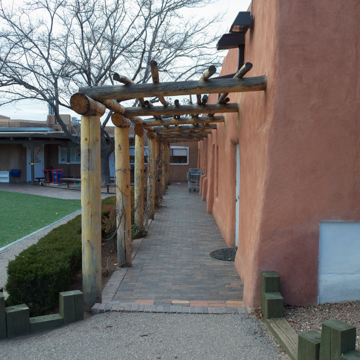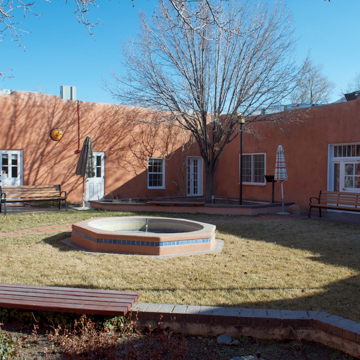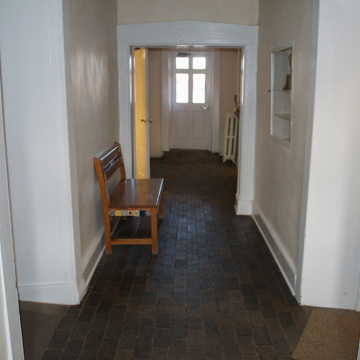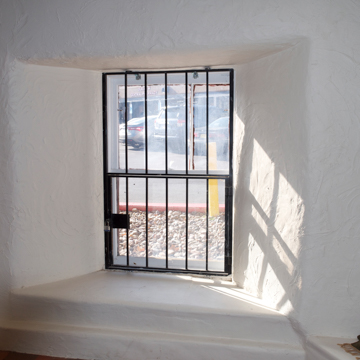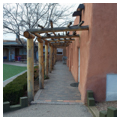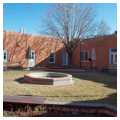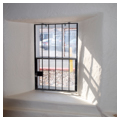You are here
Manzano Day School
La Glorieta is Albuquerque’s only surviving example of a Spanish Colonial hacienda, and an artifact of the changes effected by the city’s nineteenth-century transition from frontier village to railroad town.
Multiple building phases produced La Glorieta’s present form as a one-story, flat-roofed hacienda, with three-foot thick adobe walls and room arranged around a central placita wrapped by wooden porticos (portals). Don Diego de Trujillo, a soldier who came to the Province of New Mexico from Mexico in 1641, built the original hacienda circa 1662. The Trujillo family fled to El Paso during the Pueblo Revolt of 1680–1692, but returned in the 1690s to rebuild their partially destroyed home. It is unclear how much, if any, of this original structure survives. The oldest verifiable parts of the house date to the 1850s, when the L-shaped south and west wings were built.
Following the Americanization of New Mexico, the hacienda became associated with successive generations of three families who played prominent roles in shaping modern Albuquerque: the Hunings, the Fergussons, and the Simms. In 1861, Franz Huning acquired the eight-room hacienda and its 700 acres of land from the Franciscan friars who owned it at the time. A German immigrant who came to New Mexico in 1849 as a wagon train “bull whacker” on the Santa Fe Trail, Huning went on to make his fortune in Albuquerque as a merchant, mill operator, and land speculator. In 1880, with two other businessmen, he formed the New Mexico Town Company that developed New Town Albuquerque as the principal depot, repair yard, and division point in New Mexico for the Atchison, Topeka and Santa Fe Railroad.
Huning named the estate La Glorieta, after the Spanish word for “arbor,” and lived there until 1883, when he moved into his newly built mansion, Huning Castle; six years later, he gave La Glorieta to his daughter, Clara, after she married the local attorney, Harvey Butler Fergusson. Between 1864 and 1905, the Huning and Fergusson families added north and east wings to the house, enclosing the placita and giving La Glorieta its definitive form.
In 1940, Ruth Hanna McCormick Simms purchased La Glorieta to house the Manzano Day School. A former Illinois congresswoman from Chicago, McCormick had moved to Albuquerque in 1932, after she married the local businessman and former New Mexico congressman, Albert Gallatin Simms. Looking to provide what she saw as a proper education for her daughter and the children of like-minded families, she established the Manzano Day School in 1938.
Paradoxically, La Glorieta belonged to, and was treasured by, some of the very families who led Albuquerque’s modernization between the Civil War and World War II. The arrival of the railroad had shifted Albuquerque’s economic center from the original Plaza where Huning ran his store a short distance from La Glorieta to the New Town that sprang up alongside the railroad tracks two miles to the east. Left behind by progress, what became Albuquerque’s “Old Town” transformed itself into a tourist destination in the twentieth century by refashioning its late-nineteenth-century commercial and residential buildings into simulations of earlier Spanish Colonial structures. La Glorieta needed no such window dressing; through a long history of rebuilding and additions, it had managed to preserve its material authenticity as a vernacular adobe dwelling.
The Manzano Day School continues to use and maintain the hacienda as the centerpiece of its campus. It is closed to the public, but tours and visits can be arranged by appointment.
References
Bunting, Bainbridge. Early Architecture in New Mexico. Albuquerque, NM: University of New Mexico Press, 1976.
Dewitt, Susan. Historic Albuquerque Today. Revised second edition. Albuquerque: Historic Landmarks Survey of Albuquerque, 1978.
Fergusson, Erna. Albuquerque. Albuquerque: Merle Armitage Editions, 1947.
Mahoney, Jane. Albuquerque’s Huning Castle Neighborhoods. Charleston, SC: Arcadia Publishing, 2013.
Manzano Day School. “65 Years at Manzano Day School.” In Twigs: Winter 2004. Albuquerque, NM: Manzano Day School, 2004.
Manzano Day School. “A History of La Glorieta.” In Twigs: December 2014. Albuquerque, NM: Manzano Day School, 2014.
Simmons, Marc. Albuquerque: A Narrative History. Albuquerque: University of New Mexico, 1982.
Threinen, Ellen. Historic Architecture of Albuquerque’s Central Corridor.Albuquerque, NM: Task Force of Albuquerque Center, 1977.
Wilson, Chris. The Plazas of New Mexico. San Antonio, TX: Trinity University Press, 2011.
Writing Credits
If SAH Archipedia has been useful to you, please consider supporting it.
SAH Archipedia tells the story of the United States through its buildings, landscapes, and cities. This freely available resource empowers the public with authoritative knowledge that deepens their understanding and appreciation of the built environment. But the Society of Architectural Historians, which created SAH Archipedia with University of Virginia Press, needs your support to maintain the high-caliber research, writing, photography, cartography, editing, design, and programming that make SAH Archipedia a trusted online resource available to all who value the history of place, heritage tourism, and learning.














